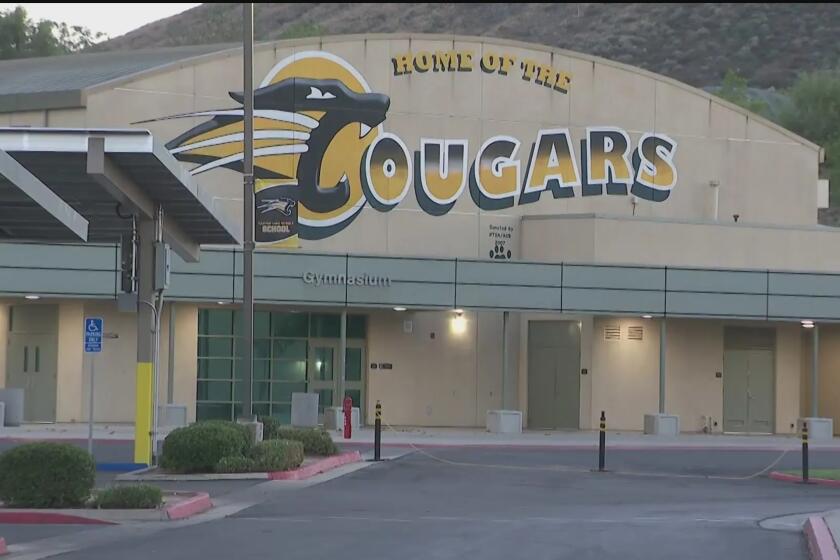How oranges made their way to California and became a famed crop

Good morning, and welcome to the Essential California newsletter. Here’s what you need to know to start your weekend:
You're reading the Essential California newsletter
Our reporters guide you through the most important news, features and recommendations of the day.
You may occasionally receive promotional content from the Los Angeles Times.
- A character-rich story of how oranges made their way to California and became a famed crop.
- The feds appear to target those involved in Sean “Diddy” Combs “freak offs” as their investigation enters a new phase.
- Should Shohei Ohtani pitch in the playoffs?
- And here’s today’s e-newspaper
The orange’s sweet and chancy journey to Southern California
You can probably tell I’m a morning person, judging by the time stamp on this newsletter. And like many people right now, I’m enjoying a glass of orange juice.
Speaking of which, if you’re looking for a fascinating story to read this weekend about the state’s past — one I personally plan on using to sound smarter around my husband — my colleague Patt Morrison tells the charming story of how oranges came to California.
It’s a tale featuring a Yankee fur trader who supposedly journeyed with pioneer Daniel Boone, a woman who apparently cosplayed as Queen Victoria and a discovery in the Brazilian Amazon that attracted the attention of the newly created U.S. Department of Agriculture.
Patt’s story feels magical when hitting the fast-forward button to today. Orange groves, which used to dominate the landscape in Southern California, have receded for housing developments over the years. Now, only 14 acres remain at the last surviving commercial citrus grove in the San Fernando Valley.
But for more than a century, the orange was “more than food — it was the symbol of the California lush life, a divine talisman of an otherworldly place,” Patt writes. “And in this oversold earthly Eden, the fruit of pleasure and delight was the orange, not the humdrum apple.”
I won’t give away the whole story, but here’s a taste.
The two types of California oranges
First there’s the Valencia orange, which came here via Spanish padres, who planted the seeds in the San Gabriel mission garden around 1804. But they had problems: Sometimes the oranges tasted bitter, and the rinds were as tough as leather.
That changed with the exceptionally well-named William Wolfskill, a fur trader who perfected the mission’s oranges and began making money.
“Wolfskill’s Valencia orange was coaxed into sweeter, sturdier qualities, and he and his son were soon shipping it eastward, and pdq, Americans cultivated a costly taste for the exotic harvests of faraway California,” Patt writes.
But it still had seeds. And here’s where the second orange enters the stage.

The navel orange took root in California thanks partly to Eliza Lovell Tibbets, who looked similar to Queen Victoria and “took to accentuating the resemblance,” Patt writes.
But despite her appearance, Eliza was a woman out of her time — she was a committed abolitionist and a tireless suffragist who was twice divorced. She and her third husband, Luther Tibbets, moved to the place we know as Riverside, where they wanted to grow a crop.
Luther wrote to the U.S. Department of Agriculture for suggestions, and his letter was delivered at the perfect time. The department had just learned of a seedless orange of “fabled sweetness,” Patt writes. A couple of trees were sent to the Tibbets, and the rest was history.
Well, actually, there’s more to the Tibbets’ story. But I promised I wouldn’t ruin it for you. Their tale has some seeds, but the last surviving tree from the couple’s grove still stands in Riverside today, fenced, guarded and commemorated with a plaque noting it as a California historic landmark.
And if you like Patt’s story, you can find a collection of her work on California’s history and culture here.
The week’s biggest stories

The feds appear to target those involved in Sean ‘Diddy’ Combs ‘freak offs’ as their investigation enters a new phase
- Prosecutors have been silent about exactly where the case against Combs is going next. But they called out employees and associates for helping the music mogul and allegedly often covering up for him.
- The allegations against Combs grew this week. A woman alleged Combs and his bodyguard drugged, bound and violently raped her decades ago, then later showed video of the attack to others.
California wages a legal battle over “deceptive” plastic recycling
- In the first lawsuit of its kind, California Atty. Gen. Rob Bonta alleged Exxon Mobil Corp. carried out a “decades-long campaign of deception” over the potential for plastic recycling.
- The lawsuit comes as a growing body of research shows the harmful effects microplastics have on the environment and within human bodies.
Unease grows among Metro riders after this week’s deadly bus hijacking
- Mayor Bass and other officials renewed promises to improve safety after an armed man hijacked a bus Wednesday morning in a violent takeover that left one passenger dead.
- Violent crimes are down slightly, according to Metro. But assaults on operators increased from 11 in May to 14 in June and 23 in July.
Should Shohei Ohtani pitch in the playoffs?
- The Dodgers aren’t even thinking about Ohtani pitching in the playoffs, said Andrew Friedman, president of baseball operations. But he isn’t completely dismissing the possibility.
- Dodgers team physician Neal ElAttrache told The Times he would prefer Ohtani’s pitching velocity stay under 90 mph for the moment but that it has crept up to 93.
- Meanwhile, Ohtani joined the 400-total base club. Only 18 other players have done it in MLB history.
More big stories
- Amazon demands a lot from its drivers. Now they’re pushing back.
- A judge halted construction of a massive warehouse project after scores of homes were already demolished.
- How will the state manage the slow death of California’s gasoline industry?
- A man accused of exploding a bomb at a California courthouse had more bomb-making materials, feds say.
- The firefighter accused of setting blazes in Northern California was a former inmate firefighter.
- Voters in this swing California district will cross party lines for “best” candidate.
Get unlimited access to the Los Angeles Times. Subscribe here.
Weekend reading
A billionaire’s son and his graffiti-scarred mansions are roiling Hollywood Hills. Property records show the mansions belong to a TV and film producer who city officials say has only recently responded to notices about the problem.
More must reads
- Southern California’s hottest commercial real estate market is for tenants that aren’t human.
- Living inside the Rancho Palos Verdes landslide zone: Darkness, propane, batteries and determination.
- ‘The best gift I’ve ever given myself’: Why adults are returning to L.A. ballet studios.
- From her tree-house studio to high-end galleries, this L.A. potter’s work is turning heads.
- A whale-watching tour got the photo opportunity of a lifetime when they spotted a rare white shark.
How can we make this newsletter more useful? Send comments to essentialcalifornia@latimes.com.
For your weekend

Going out
- 🛋️ Chairs for $30 and sofas for $80? The Times hit 11 L.A. thrift stores looking for deals.
- 🥪 Pastrami sandwich face-off: What’s the best order at Langer’s?
- 🌳 Here’s where to get free trees in Los Angeles and Orange counties.
- 🌆 Locals share their wild “only in L.A.” stories, from a freeway romance to a porn set surprise.
- 🚂 This magical Amtrak ride to New Mexico belongs on your winter bucket list.
Staying in
- 🤣 As “SNL” turns 50, celebrities and show alumni choose their top sketch of all time.
- 🛣️ The trans “Will & Grace” is here, and it’s a Netflix road movie starring Will Ferrell.
- 🌿 Growing your first outdoor pot plant? Here are four things you need to do next.
- 🍓 Plums and berries in salsa? Meet your new favorite tart, spicy, sweet, savory condiment.
- 🧑🍳 Here’s a recipe for nonna’s meatball sandwich.
- ✏️ Get our free daily crossword puzzle, Sudoku, word search and arcade games.
How well did you follow the news this week? Take our quiz.
According to Sierra Madre city officials, bears in the area have recently learned how to do what? Plus nine other questions from our weekly news quiz.
Have a great weekend, from the Essential California team
Hunter Clauss, multiplatform editor
Check our top stories, topics and the latest articles on latimes.com.
Sign up for Essential California
The most important California stories and recommendations in your inbox every morning.
You may occasionally receive promotional content from the Los Angeles Times.






